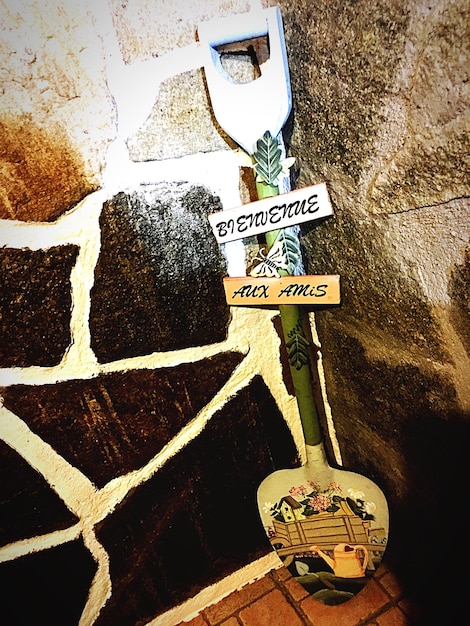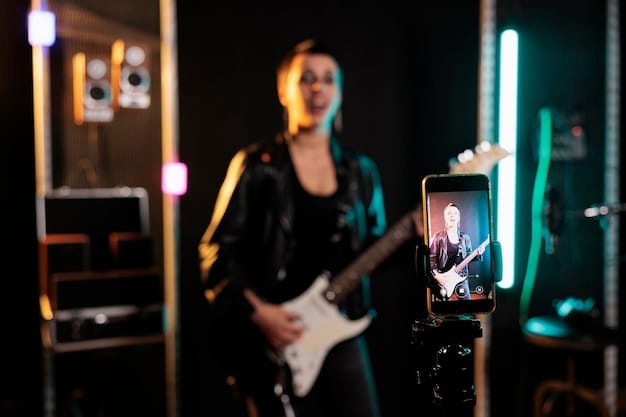The Evolution of Rock Interviews: From Print to Podcasts & Beyond

The evolution of rock interviews has transformed from print magazines to dynamic podcasts and digital platforms, reflecting changes in technology and audience consumption, enhancing accessibility, and offering more personal connections with artists.
The landscape of rock music journalism has undergone a dramatic transformation over the decades. From the grainy pages of magazines to the immersive audio experiences of podcasts, the evolution of rock interviews: from print to podcasts and beyond reflects a fascinating intersection of technology, culture, and the enduring allure of rock and roll.
From Rolling Stone to Revolver: The Golden Age of Print
In the early days, rock interviews were primarily found in print magazines. Publications like Rolling Stone, Creem, and Circus reigned supreme, shaping the narrative around rock music and its stars.
These magazines provided a platform for in-depth conversations, often spanning several pages. The interviews were substantive, offering readers a glimpse into the minds and personalities of their favorite musicians.
The Role of the Interviewer
The journalists behind these interviews were more than just reporters; they were often considered tastemakers and cultural commentators. Their writing style and approach could significantly influence how an artist was perceived.
Cameron Crowe, for example, gained notoriety for his intimate and insightful interviews, which later inspired his film “Almost Famous.” These journalists’ ability to connect with artists on a personal level made their interviews compelling and memorable.
- Hunter S Thompson: Known for his gonzo journalism style, bringing a raw and personal edge to rock interviews.
- Jann Wenner: The founder of Rolling Stone, who helped establish the magazine as a leading voice in rock journalism.
- Lester Bangs: A famously acerbic and opinionated critic who delivered provocative and often controversial interviews.

These established the ground rules for the future.
The Digital Revolution: Blogs and Online Magazines Emerge
The internet era brought about a seismic shift in how rock interviews were conducted and consumed. Blogs and online magazines became the new frontier, offering a more immediate and accessible platform for these conversations.
Sites like Pitchfork, Consequence of Sound, and countless independent music blogs began publishing interviews alongside reviews and news. This democratization of media allowed for a greater diversity of voices and perspectives.
Accessibility and Frequency
Online platforms offered several advantages over traditional print media. They could publish interviews more frequently, often in real-time, and reach a global audience instantaneously. This increased accessibility meant that fans could stay more connected with their favorite artists.
Furthermore, the interactive nature of the internet allowed for reader comments and engagement, fostering a sense of community around the interviews. Artists themselves could participate directly in the conversation, blurring the lines between creators and consumers.
- Increased Reach: Online interviews could be accessed globally, breaking geographical barriers.
- Multimedia Integration: Online platforms allowed for embedding music, videos, and other multimedia elements, enhancing the interview experience.
- Real-time Interaction: Social media integration enabled real-time engagement with fans during and after the interview.
Rock went from print to pixels.
Podcasts Take Center Stage: Audio Intimacy and Long-Form Content
Podcasts have emerged as a dominant force in the world of rock interviews. The audio format offers a unique sense of intimacy, allowing listeners to feel like they’re eavesdropping on a private conversation between the artist and interviewer.
Shows like “WTF with Marc Maron,” “Song Exploder,” and “Broken Record” have gained massive followings by showcasing in-depth interviews with rock musicians and other creatives.
Freedom and Flexibility
Podcasts allow for longer, more unstructured conversations than traditional media formats. This freedom enables interviewers to delve deeper into an artist’s background, influences, and creative process. The absence of strict time constraints often leads to more candid and revealing interviews.
The intimacy of the audio format also encourages artists to open up and share personal stories. Listeners can hear the nuances in their voices and the subtle inflections that convey emotion, creating a deeper connection with the music.
- Intimate Connection: The audio format creates a sense of personal connection between the artist and the listener.
- Long-Form Content: Podcasts allow for extended conversations, providing deeper insights into the artist’s life and work.
- On-Demand Listening: Listeners can consume podcasts at their convenience, making it a highly accessible medium.
Podcasts became extremely successful.
Video Killed the Radio Star?: The Rise of YouTube and Streaming Interviews
Video platforms such as YouTube and streaming services have further diversified the landscape of rock interviews. These platforms offer a visual component that enhances the interview experience, allowing viewers to see the artist’s expressions and body language.
Shows like “Hot Ones,” where musicians are interviewed while eating increasingly spicy chicken wings, have become viral sensations. These interviews often blend humor, personality, and insightful conversation, attracting a broad audience.
The Power of Visuals
Video interviews allow for a different kind of storytelling. They can incorporate music videos, live performances, and behind-the-scenes footage, creating a more comprehensive and engaging experience for the viewer. The visual element enables greater emotional impact and a deeper understanding of the artist’s persona.
Live streaming platforms like Twitch also offer new possibilities for real-time interaction with fans. Artists can answer questions, perform impromptu sets, and engage in spontaneous conversations, creating a sense of immediacy and authenticity.

- Visual Engagement: Video interviews add a visual dimension, enhancing the emotional impact and storytelling.
- Live Streaming: Platforms like Twitch enable real-time interaction with fans, creating a sense of immediacy and authenticity.
- Multi-Platform Distribution: Video interviews can be easily shared across various social media platforms, increasing their visibility.
Visuals are key.
Social Media and the Short-Form Interview: TikTok, Instagram, and Beyond
Social media has transformed the way rock interviews are consumed. Platforms like TikTok and Instagram have given rise to short-form interviews, often lasting only a few minutes or even seconds.
These bite-sized conversations are tailored to the fast-paced nature of social media, focusing on quick, engaging soundbites and visually appealing content. While they may lack the depth of traditional long-form interviews, they offer a unique way for artists to connect with their fans on a more personal level.
The Challenge of Brevity
The limited time constraints of social media interviews present a challenge for both interviewer and artist. They must distill their thoughts and ideas into concise, easily digestible messages. This requires a high level of communication skill and an ability to cut through the noise.
However, the immediacy and reach of social media also offer significant benefits. Artists can use these platforms to promote their latest releases, share personal updates, and engage with fans in real-time, fostering a sense of community and connection.
- Conciseness: Short-form interviews require distilling thoughts and ideas into concise messages.
- Immediacy: Social media offers real-time engagement and immediate feedback from fans.
- Accessibility: Social media platforms are easily accessible on mobile devices, making interviews available anytime, anywhere.
Social media is the current stage.
The Future of Rock Interviews: AI, Virtual Reality, and the Metaverse
Looking ahead, the future of rock interviews is likely to be shaped by emerging technologies such as artificial intelligence (AI), virtual reality (VR), and the metaverse. These technologies offer exciting new possibilities for creating immersive and interactive interview experiences.
AI could be used to generate personalized interview questions, analyze artist responses, and even create virtual avatars that can conduct interviews on behalf of the artist. VR could transport viewers to a virtual backstage environment, allowing them to experience the interview alongside the artist.
The Immersive Experience
The metaverse, a shared virtual world where users can interact using digital avatars, could become a new platform for rock interviews. Artists could host virtual Q&A sessions, perform virtual concerts, and engage with fans in a more interactive and immersive way.
These technologies have the potential to transform the interview experience from a passive act of consumption to an active act of participation. Viewers could become participants, shaping the direction of the conversation and creating a more personal and meaningful connection with the artist.
- AI Personalization: AI can generate personalized interview questions and analyze artist responses.
- VR Immersion: VR can transport viewers to virtual environments, creating a more immersive experience.
- Metaverse Interaction: The metaverse offers new platforms for virtual Q&A sessions, concerts, and interactive fan engagement.
The future has endless possibilities.
| Key Point | Brief Description |
|---|---|
| 📰 Print Media Era | Magazines like Rolling Stone defined early rock interviews. |
| 💻 Digital Platforms | Blogs and online magazines increased accessibility and frequency. |
| 🎧 Podcasts | Audio intimacy allows for longer, deeper artist conversations. |
| 📱 Social Media | Short-form interviews offer quick, engaging artist content. |
FAQ
▼
Print magazines like Rolling Stone and Creem were pivotal in shaping rock music’s narrative, providing in-depth artist conversations.
▼
Digital platforms increased accessibility and frequency, offering real-time interviews and a global audience reach for rock musicians.
▼
Podcasts provide audio intimacy, fostering deeper connections through extended conversations and nuanced emotional expression for rock artists.
▼
Video platforms enhance rock interviews with visual elements, including performances and behind-the-scenes footage, creating a richer viewing experience.
▼
Social media uses short-form interviews, offering quick, engaging content and real-time interactions, connecting rock artists with fans instantly.
Conclusion
The journey of rock interviews reflects a dynamic interplay of technology and cultural shifts, from the print era’s profound insights to the immersive, interactive experiences of today’s digital landscapes. As technologies like AI and VR evolve, the future promises even more engaging and personal artist-fan connections.





